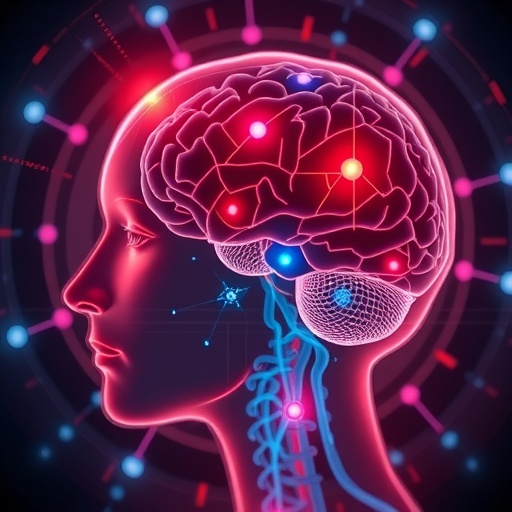Insomnia disorder, a pervasive sleep condition affecting millions globally, continues to pose significant challenges due to its profound impact on overall health and daily functioning. While various therapeutic options exist, their efficacy varies greatly among individuals. Recently, a groundbreaking study published in BMC Psychiatry introduces a novel approach to addressing this debilitating condition through model-driven, individualized transcranial direct current stimulation (tDCS), providing fresh hope for patients and clinicians alike.
The research protocol outlines a meticulously designed randomized, sham-controlled, double-blind clinical trial involving 40 patients diagnosed with insomnia disorder. This study’s cornerstone lies in the personalized mapping of brain stimulation parameters using advanced computational models, a method that promises to overcome the longstanding issue of one-size-fits-all treatment. The investigators leverage cutting-edge machine learning algorithms to tailor the electrical stimulation based on each participant’s unique brain architecture, derived from structural magnetic resonance imaging (MRI) and electroencephalography (EEG) data.
Traditional tDCS approaches, which apply a fixed configuration of currents to the scalp to modulate neuronal activity, have shown mixed results in sleep research. The innovation in this study emerges from integrating detailed neuroimaging data with sophisticated simulations of the electric field distribution within the brain. This fusion allows for optimization of current intensity, electrode placement, and stimulation duration, honing the intervention precisely to target the neural circuits implicated in insomnia.
Throughout the trial, participants will receive 10 sessions of either active or sham tDCS over two consecutive weeks, administered five days per week. The double-blind design ensures that neither the patients nor the administering clinicians know which form of stimulation is being delivered, safeguarding the study’s integrity against placebo effects. Follow-up assessments at two and four weeks post-treatment will measure a range of outcomes, with the primary endpoint centered on changes in the Insomnia Severity Index (ISI) score, a widely recognized metric for quantifying the severity of insomnia symptoms.
In addition to sleep quality metrics, the researchers investigate secondary outcomes including objective sleep parameters, as well as symptoms of anxiety and depression, which frequently co-occur with insomnia. This comprehensive approach aims to illuminate how individualized brain stimulation may not only restore healthier sleep patterns but also alleviate psychological distress, potentially offering a multifaceted therapeutic benefit.
The methodology underpinning this study represents a convergence of neuroscience, biomedical engineering, and artificial intelligence. Machine learning algorithms analyze vast datasets of neuroimaging and electrophysiological signals to construct individualized electric field models. These models predict how the applied currents penetrate various brain regions, allowing for the customization of stimulation protocols in a way that maximizes efficacy while minimizing side effects.
Moreover, by employing EEG alongside MRI, the researchers incorporate both structural and functional brain data, capturing the dynamic electrical activity underlying sleep regulation. This integrative biomarker approach marks a significant leap towards precision medicine in neuromodulation, fostering tailored interventions that reflect the unique neurobiological substrates of each patient’s insomnia.
The study’s anticipated outcomes could revolutionize how chronic insomnia is treated, particularly for patients who are refractory to conventional pharmacological and behavioral therapies. By demonstrating the clinical effectiveness of model-driven tDCS, this research lays the groundwork for a new class of personalized neuromodulatory treatments that harness the power of brain imaging and AI-powered modeling.
Furthermore, the implementation of a rigorous sham-controlled design addresses the critical issue of placebo response, which has historically complicated the interpretation of neuromodulation trials. This methodological rigor strengthens the validity of the findings and paves the way for regulatory approvals and clinical adoption.
The trial is registered at ClinicalTrials.gov under the identifier NCT06671457 and began enrollment in November 2024. The research team, led by Wang, Jia, and Zhang, envisions that their integrative approach could unlock untapped therapeutic potential, making brain stimulation an accessible and standardized treatment for insomnia disorders worldwide.
Beyond its immediate clinical implications, this study also contributes valuable insights into the pathophysiology of insomnia by probing how targeted modulation of specific brain networks influences sleep architecture. These mechanistic insights could inform future innovations in neurotherapeutics and enhance our understanding of brain-behavior relationships.
The fusion of neuroengineering and clinical psychiatry represented in this work exemplifies the rapid evolution of brain stimulation technologies. It echoes a broader trend in neuroscience aimed at tailoring interventions through precision diagnostics, ultimately striving for improved patient outcomes through individualized medicine.
As the trial progresses, the medical community awaits the results with anticipation, hoping that this novel, model-driven tDCS approach will open new avenues for safe, effective, and personalized treatment options that significantly improve the lives of those struggling with insomnia.
Subject of Research: The efficacy of model-driven individualized transcranial direct current stimulation (tDCS) for treating insomnia disorder through a randomized, sham-controlled, double-blind trial.
Article Title: Model-driven individualized transcranial direct current stimulation for the treatment of insomnia disorder: protocol for a randomized, sham-controlled, double-blind study.
Article References:
Wang, Y., Jia, W., Zhang, Z. et al. Model-driven individualized transcranial direct current stimulation for the treatment of insomnia disorder: protocol for a randomized, sham-controlled, double-blind study. BMC Psychiatry 25, 869 (2025). https://doi.org/10.1186/s12888-025-07347-5
Image Credits: AI Generated
DOI: https://doi.org/10.1186/s12888-025-07347-5




